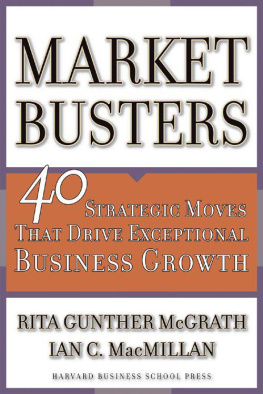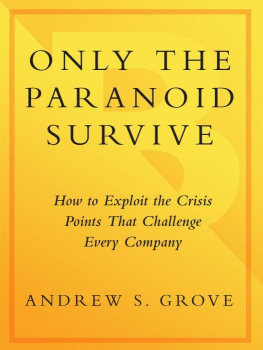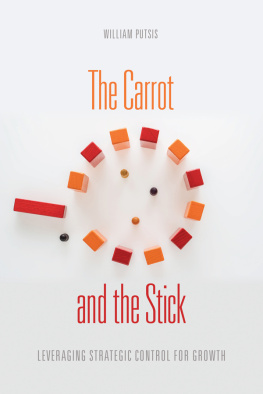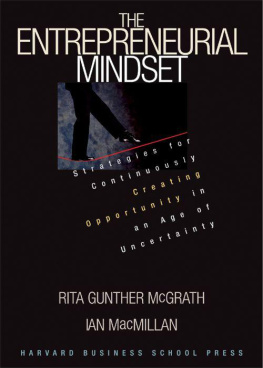Copyright 2019 by Rita McGrath
All rights reserved
For information about permission to reproduce selections from this book, write to or to Permissions, Houghton Mifflin Harcourt Publishing Company, 3 Park Avenue, 19th Floor, New York, New York 10016.
hmhbooks.com
Library of Congress Cataloging-in-Publication Data is available.
ISBN 978-0-358-02233-6
ISBN 978-0-358-23707-5 (international edition)
Cover design by Michaela Sullivan
Cover photograph: iStock / Getty Images Plus
Author photograph Evelyn Reinson
eISBN 978-0-358-01897-1
v1.0819
In one of my last conversations with my mother, Helge-Liane Gunther, she made a big effort to say something that was clearly important to her: Im proud of you. It shouldnt have mattered that much, but it did. A lot.
She was extraordinary. A scientist, when that was rare. A pathbreaking researcher whose work was cited for decades after she completed it. And the heart and soul of our family.
Id like to pass her thought along.
To our daughter, Anne, and the amazing women coming into their own along with her: Im proud of you.
Foreword
As hard as it may be to remember now, there was a time, not so long ago, when no one was talking about disruption. Innovation, back then, was a niche topic of interest to only a few. The consequences of digital transformation were only dimly anticipated. Thirty years ago, that was the world we lived in.
Even then, however, the early warnings were clear to a few of us. Rita McGrath and I were both pursuing our doctoral degrees in the late 1980sshe at Wharton and I at Harvard. Both of us intuited that the assumptions underlying theories of success in business at the time were on the brink of major challenge. In my case, the big idea was that assumptions about good management would lead to corporate disaster as leaders faced what I came to call the innovators dilemma. In her case, the big idea was that approaching highly uncertain projects as though they were business as usual was a trap. Both ideas were published in the Harvard Business Review in 1995.
We were challenging orthodoxyin fact, we are still challenging orthodoxy.
This orthodoxy is based on assumptions that in todays competitive environment are simply not correct. Big market share is good, for example. Rita and I would ask, Market share, meaning what? The very concept of industry is an artificial categorization. Often the most important competition any business will face is from entrants who are not hamstrung by assumptions about what their industry expects of them. Addressing this reality may be challenging, but it can be strategically navigated with a useful theorya statement of what causes things to happen, and why.
The terms theory and theoretical often connote impractical. But theories are statements of cause and effectwhich actions yield which results, and why. As such, a good theory is consummately practical. Every time a manager makes a plan or takes an action it is predicated on a belief that they will get an expected result. Managers, therefore, are voracious consumers of theory. The more we understand what causes things to happen, the more we can help managers understand that in these circumstances you should do this, but in those circumstances you should do that. These cause-and-effect relationships offer clarity and predictability to what otherwise might seem like a game of chance.
The first step toward developing any useful theory is getting the categories right. In my previous work, I realized that product or demographic segmentation were the wrong categories when trying to predict purchase behavior. As Peter Drucker famously said, The customer rarely buys what the company thinks its selling him. This led me to discover the theory of jobs to be done, which asserts that people buy products and services because they are trying to make progress in their lives. Once people realize they have a job to do, they reach out and hire (or fire) a product to get that job done.
Rita McGrath insightfully builds on that research to introduce a new category that basically rips apart decades of strategic thinking in which where you are in an industry determines your fate. Thinking in terms of an arena, rather than an industry, McGrath suggests, means that markets are no longer defined by product category but rather by the jobs that people are trying to get done in their lives. This concept offers a much more powerful categorization scheme for managers navigating disruptive change.
She then goes a step further to illuminate not just the what but the how of successful innovation. Her theory of discovery-driven planning helps managers discover the future while simultaneously containing risk. Ive long been convinced of the power of this theoryit is required reading in my course at Harvard Business School and is used extensively in our strategy consulting work at Innosight.
Innovation doesnt have to be a painful hit-and-miss effort. Though disruption is constantly on the horizon, managers dont need to be blind when charting their course. Seeing Around Corners will help those of us who seek to better understandand even anticipatewhat innovation will bring us next.
Clayton M. Christensen
Spring 2019
Introduction
Some years ago, Andy Grove introduced the concept of strategic inflection points in his landmark book Only the Paranoid Survive. A strategic inflection point, he observed, is a time in the life of a business when its fundamentals are about to change. And that is how many of us experience inflection pointsas a single moment in time when everything changes irrevocably.
When you look at the true nature of strategic inflection points, you see a different story. It is similar to the way in which Hemingways character Mike Campbell in The Sun Also Rises responds to being asked how he went bankrupt. Gradually, he says, then suddenly.
An inflection point is a change in the business environment that dramatically shifts some element of your activities, throwing certain taken-for-granted assumptions into question. Someone, somewhere, sees the implications, but all too often they are not heard. That someone might be you!
This book will help you see the opportunities represented by strategic inflection points and help you, your team, and your organization take advantage of them. There are three major ideas to grab hold of here.
- What you experience as a big, dramatic inflection point has almost always been gestating for a while.
- This creates opportunity: if you see it earlyor even better, spark itan inflection point can be a strategic boon.
- You can use tools from the discovery-driven growth playbook to maximize your opportunities.
Lets take a concrete example.
Imagine a sector that effectively serves only one in five potential customers. Now imagine a massive change that would allow competitors to capture all that unmet demand in a highly profitable way and without taking on a lot of risk. Imagine that the sector as it is generates about $8 billion in revenue annually. The postinflection point sector could be five times that size, meaning that some $40 billion or so in revenue could potentially be unlocked for those competitors adroit and farsighted enough to be at the right place when the inflection point does its work.
Though they are often depicted as disruptive destroyers of existing businesses, inflection points create vast new spaces even as they destroy outdated technologies and models. Famed economist Joseph Schumpeter said it decades agoincumbents in a sector are always vulnerable to the perennial gale of creative destruction, which sweeps away the old and outdated, and introduces the new and more desirable.
















